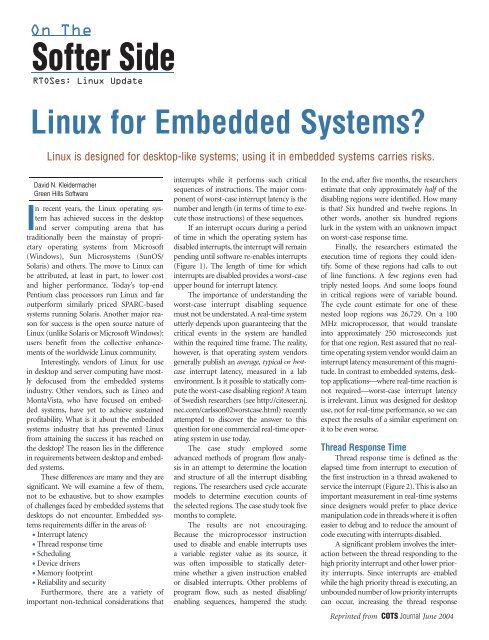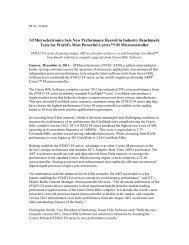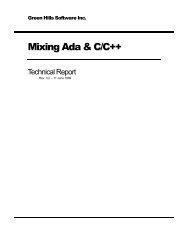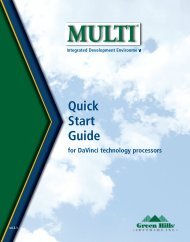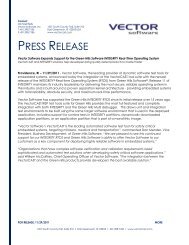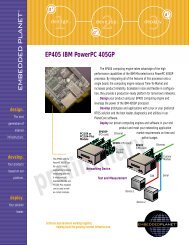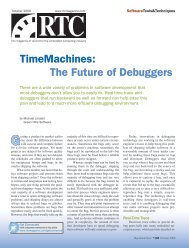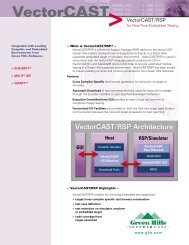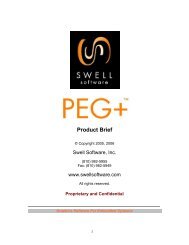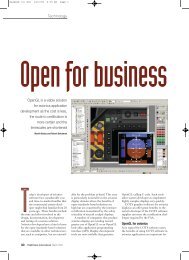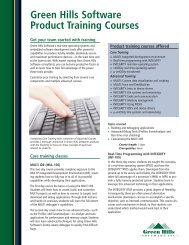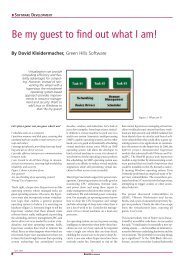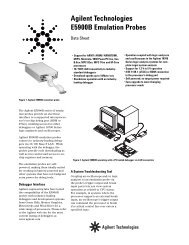Linux for Embedded Systems? - Green Hills Software
Linux for Embedded Systems? - Green Hills Software
Linux for Embedded Systems? - Green Hills Software
You also want an ePaper? Increase the reach of your titles
YUMPU automatically turns print PDFs into web optimized ePapers that Google loves.
On The<br />
Softer Side<br />
RTOSes: <strong>Linux</strong> Update<br />
<strong>Linux</strong> <strong>for</strong> <strong>Embedded</strong> <strong>Systems</strong>?<br />
<strong>Linux</strong> is designed <strong>for</strong> desktop-like systems; using it in embedded systems carries risks.<br />
David N. Kleidermacher<br />
<strong>Green</strong> <strong>Hills</strong> <strong>Software</strong><br />
In recent years, the <strong>Linux</strong> operating system<br />
has achieved success in the desktop<br />
and server computing arena that has<br />
traditionally been the mainstay of proprietary<br />
operating systems from Microsoft<br />
(Windows), Sun Microsystems (SunOS/<br />
Solaris) and others. The move to <strong>Linux</strong> can<br />
be attributed, at least in part, to lower cost<br />
and higher per<strong>for</strong>mance. Today’s top-end<br />
Pentium class processors run <strong>Linux</strong> and far<br />
outper<strong>for</strong>m similarly priced SPARC-based<br />
systems running Solaris. Another major reason<br />
<strong>for</strong> success is the open source nature of<br />
<strong>Linux</strong> (unlike Solaris or Microsoft Windows):<br />
users benefit from the collective enhancements<br />
of the worldwide <strong>Linux</strong> community.<br />
Interestingly, vendors of <strong>Linux</strong> <strong>for</strong> use<br />
in desktop and server computing have mostly<br />
defocused from the embedded systems<br />
industry. Other vendors, such as Lineo and<br />
MontaVista, who have focused on embedded<br />
systems, have yet to achieve sustained<br />
profitability. What is it about the embedded<br />
systems industry that has prevented <strong>Linux</strong><br />
from attaining the success it has reached on<br />
the desktop? The reason lies in the difference<br />
in requirements between desktop and embedded<br />
systems.<br />
These differences are many and they are<br />
significant. We will examine a few of them,<br />
not to be exhaustive, but to show examples<br />
of challenges faced by embedded systems that<br />
desktops do not encounter. <strong>Embedded</strong> systems<br />
requirements differ in the areas of:<br />
• Interrupt latency<br />
• Thread response time<br />
• Scheduling<br />
• Device drivers<br />
• Memory footprint<br />
• Reliability and security<br />
Furthermore, there are a variety of<br />
important non-technical considerations that<br />
interrupts while it per<strong>for</strong>ms such critical<br />
sequences of instructions. The major component<br />
of worst-case interrupt latency is the<br />
number and length (in terms of time to execute<br />
those instructions) of these sequences.<br />
If an interrupt occurs during a period<br />
of time in which the operating system has<br />
disabled interrupts, the interrupt will remain<br />
pending until software re-enables interrupts<br />
(Figure 1). The length of time <strong>for</strong> which<br />
interrupts are disabled provides a worst-case<br />
upper bound <strong>for</strong> interrupt latency.<br />
The importance of understanding the<br />
worst-case interrupt disabling sequence<br />
must not be understated. A real-time system<br />
utterly depends upon guaranteeing that the<br />
critical events in the system are handled<br />
within the required time frame. The reality,<br />
however, is that operating system vendors<br />
generally publish an average, typical or<br />
bestcase<br />
interrupt latency, measured in a lab<br />
environment. Is it possible to statically compute<br />
the worst-case disabling region? A team<br />
of Swedish researchers (see http://citeseer.nj.<br />
nec.com/carlsson02worstcase.html) recently<br />
attempted to discover the answer to this<br />
question <strong>for</strong> one commercial real-time operating<br />
system in use today.<br />
The case study employed some<br />
advanced methods of program flow analysis<br />
in an attempt to determine the location<br />
and structure of all the interrupt disabling<br />
regions. The researchers used cycle accurate<br />
models to determine execution counts of<br />
the selected regions. The case study took five<br />
months to complete.<br />
The results are not encouraging.<br />
Because the microprocessor instruction<br />
used to disable and enable interrupts uses<br />
a variable register value as its source, it<br />
was often impossible to statically determine<br />
whether a given instruction enabled<br />
or disabled interrupts. Other problems of<br />
program flow, such as nested disabling/<br />
enabling sequences, hampered the study.<br />
In the end, after five months, the researchers<br />
estimate that only approximately half of the<br />
disabling regions were identified. How many<br />
is that? Six hundred and twelve regions. In<br />
other words, another six hundred regions<br />
lurk in the system with an unknown impact<br />
on worst-case response time.<br />
Finally, the researchers estimated the<br />
execution time of regions they could identify.<br />
Some of these regions had calls to out<br />
of line functions. A few regions even had<br />
triply nested loops. And some loops found<br />
in critical regions were of variable bound.<br />
The cycle count estimate <strong>for</strong> one of these<br />
nested loop regions was 26,729. On a 100<br />
MHz microprocessor, that would translate<br />
into approximately 250 microseconds just<br />
<strong>for</strong> that one region. Rest assured that no realtime<br />
operating system vendor would claim an<br />
interrupt latency measurement of this magnitude.<br />
In contrast to embedded systems, desktop<br />
applications—where real-time reaction is<br />
not required—worst-case interrupt latency<br />
is irrelevant. <strong>Linux</strong> was designed <strong>for</strong> desktop<br />
use, not <strong>for</strong> real-time per<strong>for</strong>mance, so we can<br />
expect the results of a similar experiment on<br />
it to be even worse.<br />
Thread Response Time<br />
Thread response time is defined as the<br />
elapsed time from interrupt to execution of<br />
the first instruction in a thread awakened to<br />
service the interrupt (Figure 2). This is also an<br />
important measurement in real-time systems<br />
since designers would prefer to place device<br />
manipulation code in threads where it is often<br />
easier to debug and to reduce the amount of<br />
code executing with interrupts disabled.<br />
A significant problem involves the interaction<br />
between the thread responding to the<br />
high priority interrupt and other lower priority<br />
interrupts. Since interrupts are enabled<br />
while the high priority thread is executing, an<br />
unbounded number of low priority interrupts<br />
can occur, increasing the thread response<br />
Reprinted from COTS Journal June 2004
The Softer Side<br />
Thread 1<br />
Figure 1<br />
Interrupt latency is a critical factor in embedded systems, but it must take into account any<br />
OS decision to disable interrupts.<br />
Thread 1<br />
Interrupt Occurs<br />
Interrupt Occurs<br />
Figure 2<br />
OS service call critical<br />
section<br />
Interrupts<br />
Disabled<br />
Interrupt<br />
latency<br />
Interrupts<br />
Enabled<br />
OS service call critical<br />
section<br />
Interrupts<br />
Disabled<br />
Interrupt<br />
latency<br />
time as each interrupt service routine is<br />
executed. This is an example of “priority<br />
inversion,” since an essentially unbounded<br />
amount of low priority execution can delay<br />
the execution of higher priority work. In<br />
desktop systems, such inversions are unimportant;<br />
delays are usually not noticeable by<br />
the human user, and in a worst-case lock-up,<br />
one can simply re-boot.<br />
A real-time operating system, though,<br />
should provide a method of preventing this<br />
kind of priority inversion. One solution is to<br />
enable device driver designers to prioritize<br />
interrupts below critical interrupt handling<br />
threads. When a thread is scheduled, the kernel<br />
inhibits the interrupts that are assigned a<br />
lower priority than the thread. When there<br />
is no higher priority thread to run, the lower<br />
priority interrupts are re-enabled; a simple<br />
yet effective solution.<br />
Scheduling<br />
<strong>Linux</strong> has no such provision <strong>for</strong> prioritizing<br />
threads relative to interrupts; howev-<br />
Reprinted from COTS Journal June 2004<br />
Processor<br />
Response<br />
Time<br />
ISR<br />
Processor<br />
Response<br />
Time<br />
Interrupts<br />
Enabled<br />
ISR<br />
Context<br />
switch<br />
Context<br />
switch<br />
Thread 2<br />
Thread 2<br />
Thread response time takes into account the time from an interrupt to execution of the first<br />
instruction in an awakened thread that will service the interrupt.<br />
er, the actual situation is worse. Real-time<br />
operating systems provide priority-based<br />
scheduling because it must be possible to<br />
guarantee that the most critical threads<br />
in the system can run immediately in<br />
response to an event. It is <strong>for</strong>bidden to<br />
use heuristics or any other constructs in<br />
the kernel that might make this response<br />
nondeterministic.<br />
The standard <strong>Linux</strong> scheduler is a fairness-based<br />
heuristic scheduler. This comes<br />
from <strong>Linux</strong>’s UNIX heritage as a time-sharing,<br />
interactive operating system. Thus, it is<br />
not possible <strong>for</strong> the designer to specify an<br />
absolute “highest” priority thread. When an<br />
interrupt handler makes a thread ready to<br />
run in order to process the event, the <strong>Linux</strong><br />
scheduler is quite likely to choose some<br />
other thread to run first. It simply isn’t<br />
possible to determine the worst case thread<br />
response time.<br />
The 2.6 version <strong>Linux</strong> kernel does have<br />
some scheduling per<strong>for</strong>mance improvements<br />
over earlier 2.4 vintage kernels,<br />
but the real-time behavior is still not there.<br />
According to Red Hat (http://people.redhat.<br />
com/drepper/nptl-design.pdf), “Real time<br />
support is mostly missing from the library<br />
implementation. The system calls to select<br />
scheduling parameters are available but they<br />
have no effects. The reason <strong>for</strong> this is that<br />
large parts of the kernel do not follow the<br />
rules <strong>for</strong> real-time scheduling…and there<br />
are additional places where the kernel misses<br />
appropriate real-time support.”<br />
In addition to long interrupt latency,<br />
<strong>Linux</strong> disables preemption or dispatching<br />
<strong>for</strong> very long periods of time (even using the<br />
“preemption patch” that is now standard in<br />
the 2.6 kernel). A recent article (http://www.<br />
eet.com/sys/news/OEG20030908S0064) notes<br />
a 2.6 kernel response time of 1.2 milliseconds,<br />
whereas a real-time embedded operating system<br />
can often achieve worst-case times in the<br />
sub-microsecond range (obviously all these<br />
numbers depend on the particular hardware<br />
configuration). Furthermore, the measured<br />
times <strong>for</strong> <strong>Linux</strong> do not reflect the theoretical<br />
worst-case times. No one truly knows what<br />
the worst-case response times are <strong>for</strong> <strong>Linux</strong>—<br />
that is unacceptable <strong>for</strong> real-time systems.<br />
Device Drivers<br />
Device driver code adds less risk to the<br />
system if it runs in its own protected address<br />
space. An operating system architecture<br />
designed to facilitate virtual device drivers<br />
(Figure 3) is preferred over the traditional<br />
method of requiring device drivers to run<br />
in physical memory along with the kernel.<br />
This requires a flexible yet powerful and<br />
efficient API <strong>for</strong> providing the virtual device<br />
driver with secure access to the physical device<br />
resources it requires.<br />
<strong>Linux</strong> lacks this architecture. In fact,<br />
despite offering protected virtual memory <strong>for</strong><br />
applications, <strong>Linux</strong> promotes the addition of<br />
complicated device drivers into the physical<br />
kernel address space where it adds the most<br />
risk. The traditional method of adding a new<br />
<strong>Linux</strong> device driver is to compile the driver<br />
code into object files and then either link them<br />
into the kernel or load them dynamically via<br />
the insmod kernel module loader. These driv-<br />
ers have unfettered access to physical memory<br />
and are difficult to debug. Kernel-resident<br />
drivers are also the source of security attacks<br />
against monolithic kernels like <strong>Linux</strong> and<br />
Windows: a faulty device driver can overflow<br />
its run-time stack, polluting the kernel with
<strong>for</strong>eign data that can then be executed as code<br />
to take control over the system.<br />
The monolithic design of <strong>Linux</strong> also has<br />
repercussions in terms of system robustness,<br />
reliability and security (more on this later). A<br />
better architecture, found in a few embedded<br />
operating systems, is to employ a microkernel<br />
and push device drivers, networking stacks,<br />
file systems and other complicated software<br />
into application space where they cannot<br />
harm the kernel or other applications.<br />
Perceived to be Free<br />
The hidden “royalty” due to <strong>Linux</strong>’s<br />
large footprint is just one example of the misconception<br />
that <strong>Linux</strong> is “free”. MontaVista,<br />
purveyors of the “Hard Hat” flavor of <strong>Linux</strong>,<br />
charges $15,000 per developer per year to<br />
support its version of <strong>Linux</strong>. Over five years,<br />
the investment <strong>for</strong> a team of only five developers<br />
would be $375,000. Many proprietary<br />
embedded operating system solutions are<br />
priced much lower than this. The total cost<br />
of using a commercial <strong>Linux</strong> distribution<br />
is often more expensive than a proprietary<br />
solution.<br />
Many customers have avoided these<br />
costly <strong>Linux</strong> vendors, instead, choosing to<br />
download <strong>Linux</strong> from the Internet and get<br />
their own <strong>Linux</strong> “gurus” to handle all of the<br />
<strong>Linux</strong> support issues. Un<strong>for</strong>tunately, these<br />
organizations often underestimate the cost of<br />
supporting <strong>Linux</strong> internally. Some companies<br />
boast that they only need one full-time <strong>Linux</strong><br />
“hacker” on staff. At a conservative estimate<br />
of $150,000 per year <strong>for</strong> a fully burdened<br />
engineer, the five year cost of this approach<br />
is $750,000, dwarfing the cost of most purchased<br />
proprietary solutions. And although<br />
the local guru may be able to handle myriad<br />
<strong>Linux</strong> support issues, clearly there is a limit to<br />
what can be accomplished without being the<br />
original author of the product.<br />
Because of the high cost of supporting<br />
<strong>Linux</strong> relative to many proprietary solutions,<br />
many customers—who have attempted to<br />
use <strong>Linux</strong> only to discover this reality—have<br />
come to use the term “perceived to be free”.<br />
They have learned from difficult experience<br />
that perception sometimes falls short of<br />
reality.<br />
Long Term Support<br />
Most embedded products have a shelf<br />
life of several years. An aircraft avionics system<br />
may be in development <strong>for</strong> as long as a<br />
Figure 3<br />
Virtual Device Driver Virtual Device Driver<br />
Virtual<br />
Device<br />
Driver<br />
Thread<br />
Virtual<br />
Device<br />
Driver<br />
Thread<br />
I/O<br />
Device<br />
API Microkernel<br />
must be taken into account when thinking<br />
about using <strong>Linux</strong> in an embedded device.<br />
Interrupt Latency<br />
By definition, a real-time system<br />
is one in which an event (<strong>for</strong> example,<br />
an interrupt from an important peri-pheral<br />
device) must be handled within a bounded<br />
(and typically short) amount of time; failure<br />
to respond causes a failure in the embedded<br />
system. Many embedded systems have realtime<br />
requirements; desktop systems do not.<br />
Along with context switch time, interrupt<br />
latency is the most often analyzed and benchmarked<br />
measurement <strong>for</strong> embedded realtime<br />
systems. Operating system architecture<br />
is the most significant factor <strong>for</strong> determining<br />
interrupt latency and thread response times<br />
in an embedded system.<br />
Interrupt latency is defined as the elapsed<br />
time between an interrupt and the execution<br />
of the first instruction in the corresponding<br />
interrupt service routine. Interrupts are<br />
typically prioritized (by hardware) and nest;<br />
there<strong>for</strong>e, the latency of the highest priority<br />
interrupt is usually examined. How can software<br />
increase interrupt latency? By actually<br />
deferring interrupt processing during certain<br />
“critical” operating system operations. The<br />
operating system does this by “disabling”<br />
ISR ISR ISR<br />
The Softer Side<br />
Virtual<br />
Device<br />
Driver<br />
Thread<br />
Mapped Video RAM<br />
Interrupt Service Routines (ISR) wake up user-space threads to handle device management<br />
complexity outside the kernel; some devices are not interrupt driven and instead just<br />
operate on device-specific memory that is mapped into the process.<br />
decade be<strong>for</strong>e it is fielded, and then it might<br />
remain in service <strong>for</strong> much longer than that.<br />
Even the life of a handheld PDA may span<br />
multiple years from the start of development<br />
until obsolescence.<br />
<strong>Embedded</strong> systems developers put a<br />
high value on a vendor that has a stable, successful,<br />
proven business model, because they<br />
must rely on that vendor to support their<br />
electronic products <strong>for</strong> such an extended<br />
period of time and to be around <strong>for</strong> the next<br />
generation of product development as well.<br />
Many embedded <strong>Linux</strong> vendors have<br />
come to the realization that their support<br />
and services business models do not lend<br />
themselves to the long-term growth that<br />
investors demand. The reason is simple: support<br />
and services are manpower-intensive.<br />
The only way to increase revenues is to proportionally<br />
increase the engineering support<br />
staff. Most companies make money by engineering<br />
a new product and using relatively<br />
low overhead to sell that product over and<br />
over again.<br />
Some of these vendors have realized<br />
this predicament and are now dabbling in<br />
proprietary extensions and other software<br />
“add-ons” that they can sell. Alas, this is a<br />
Catch-22 situation: by adding proprietary<br />
extensions, a <strong>Linux</strong> vendor positions itself as<br />
Reprinted from COTS Journal June 2004
The Softer Side<br />
just another proprietary solutions provider.<br />
The <strong>Linux</strong> community will not accept nor<br />
enhance proprietary extensions.<br />
The GPL<br />
<strong>Linux</strong> is licensed under the GNU Public<br />
License (GPL), which governs how companies<br />
may incorporate the licensed software<br />
into the products that they sell to their customers.<br />
Much has been written about the<br />
pitfalls of incorporating GPL software into a<br />
product. An often overlooked consideration,<br />
however, are the costs of having to even<br />
worry about these licensing issues. The obvi-<br />
ous concern is whether a proprietary product<br />
will be subject to the GPL because of its use<br />
of a GPL product.<br />
The operating system is an important<br />
portion of the overall embedded system.<br />
Every single unit of the final electronic product<br />
will be shipped with a copy of the operating<br />
system under the hood. From the GPL<br />
Section 2b (emphasis added): “You must<br />
cause any work that you distribute or publish,<br />
that in whole or in part contains or is<br />
derived from [<strong>Linux</strong>] or any part thereof,<br />
to be licensed as a whole at no charge to<br />
all third parties under the terms of this<br />
License.” Companies cannot undertake the<br />
risk of incorporating a GPL product without<br />
the knowledge that their own intellectual<br />
property will not be <strong>for</strong>ced into the public<br />
domain because of the use of software that<br />
follows the GPL.<br />
Companies spend a lot of money<br />
researching the implications of using this<br />
GPL software. Some customers have legal<br />
teams dedicated to these software licensing<br />
issues alone. The legal costs of dealing with<br />
standard third-party licensing is comparatively<br />
low.<br />
What some of these legal teams have<br />
discovered is that there is a lot of gray<br />
area with respect to the interpretation<br />
of the GPL. There are few cases to use<br />
<strong>for</strong> precedence. And influential people<br />
in the <strong>Linux</strong> community often disagree<br />
regarding the application of the GPL. A<br />
notable example is the <strong>Linux</strong> “loadable<br />
module”. As described earlier, <strong>Linux</strong> users<br />
can dynamically load modules directly<br />
into the kernel.<br />
Some well-known members of the<br />
<strong>Linux</strong> community are adamant that loadable<br />
modules should be subjected to the GPL<br />
license. Yet Linus Torvalds, inventor of <strong>Linux</strong>,<br />
Reprinted from COTS Journal June 2004<br />
has taken the opposite view, stating that loadable<br />
modules should not be subject to the<br />
GPL. Still others state that the applicability<br />
of the GPL depends on the manner in which<br />
the loadable module interacts with the kernel<br />
(<strong>for</strong> example, whether any data structures are<br />
shared). Most legal teams are not happy when<br />
there is no set rule <strong>for</strong> something like this:<br />
gray area implies risk.<br />
A separate area of the GPL that poses<br />
challenges to companies attempting to incorporate<br />
open source software into their products<br />
is patent infringement and copyright. The<br />
GPL does not guarantee users that licensed<br />
code is free from copyright infringement,<br />
and it does not guarantee that code does not<br />
violate existing patents. In fact, it explicitly<br />
states that it makes no such assertions, leaving<br />
users on their own to face potential patent<br />
and copyright infringement penalties down<br />
the road. If this happens after thousands of<br />
units have been produced, sold and shipped,<br />
the manufacturer might face an incredibly<br />
complex recall and/or royalty fee demand<br />
from the copyright/patent holder.<br />
Open Source vs. Open Standard<br />
Some people are under the false impression<br />
that <strong>Linux</strong> is an open standard. Open<br />
source software is freely available and modifiable.<br />
An open standard is a specification that<br />
is freely available <strong>for</strong> all to read and implement<br />
with the goal of increasing portability<br />
and avoiding getting locked into a particular<br />
vendor. There is no specification <strong>for</strong> <strong>Linux</strong>,<br />
and the fractured state of modified <strong>Linux</strong><br />
distributions and vendors causes non-portability<br />
in some areas.<br />
POSIX (Portable Operating System<br />
Interface) is an example of an open standard.<br />
In fact, it is a standard that describes application<br />
interfaces to operating systems. There are<br />
several proprietary operating system vendors<br />
that provide a POSIX-con<strong>for</strong>mant interface<br />
<strong>for</strong> their products. This allows developers to<br />
use the proprietary operating system without<br />
getting locked into it; developers can take<br />
the same code and easily move it to another<br />
POSIX-con<strong>for</strong>mant operating system.<br />
For 30 years, UNIX operating systems<br />
have defined a common set of interfaces that<br />
are the basis <strong>for</strong> today’s POSIX standard (the<br />
latest standard, POSIX.1-2001, was recently<br />
updated and released in 2003). One would<br />
think that with its UNIX heritage, <strong>Linux</strong><br />
too would be POSIX con<strong>for</strong>mant. Not so.<br />
Although <strong>Linux</strong> has a POSIX-like interface,<br />
it is not con<strong>for</strong>mant in several key areas<br />
(such as scheduling, described earlier, signals,<br />
and thread implementations). Even the<br />
latest release of the <strong>Linux</strong> threads library<br />
(called the NPTL, Native POSIX Thread<br />
Library <strong>for</strong> <strong>Linux</strong>) is not POSIX-con<strong>for</strong>mant.<br />
Developers writing portable POSIX applications<br />
may find that their code does not work<br />
on <strong>Linux</strong> and vice-versa.<br />
These differences may be subtle or catastrophic.<br />
One known problem is in the<br />
implementation of the setuid system call.<br />
POSIX requires that a setuid invocation<br />
apply to all threads in the process, but on<br />
<strong>Linux</strong>, only the calling thread is affected.<br />
POSIX programs are sometimes created (<strong>for</strong><br />
example, by an authorized system administrator)<br />
with “super-user” privileges, which<br />
give them complete system access, including<br />
the ability to delete any user’s files on<br />
the computer’s hard drive. Sometimes these<br />
programs will programmatically (using the<br />
setuid call) lower their own privilege <strong>for</strong> security<br />
reasons after executing an initial trusted<br />
super-user activity.<br />
A POSIX-con<strong>for</strong>mant program running<br />
on <strong>Linux</strong> will find that any threads created<br />
prior to the setuid call still have super-user<br />
privilege after the call. An erroneous (or<br />
worse, subverted) program that is unable to<br />
do any harm on a POSIX-con<strong>for</strong>mant operating<br />
system now has the ability to do very<br />
bad things on a <strong>Linux</strong> system.<br />
One might also think that the developers<br />
of an open source operating system<br />
might also be in favor of open operating<br />
system standards. Linus Torvalds has<br />
in fact spoken out against POSIX (http://<br />
www.uwsg.iu.edu/hypermail/linux/kernel/0208.0/0427.html),<br />
saying “POSIX is a<br />
hobbled standard, and does not matter. We’re<br />
not making a POSIX-compliant OS.” Will<br />
<strong>Linux</strong> ever be POSIX-con<strong>for</strong>mant? According<br />
to Linus, “The fact is, there is…zero… reason<br />
to change existing functionality.”<br />
<strong>Green</strong> <strong>Hills</strong> <strong>Software</strong><br />
Santa Barbara, CA.<br />
(805) 965-6044.<br />
[www.ghs.com].


